|
|
|
|
Group Finance Director's review |
|
"Strong growth in selective
lending increases income and places the Group in a healthy position for
the future."
Rosemary Thorne Group Finance Director
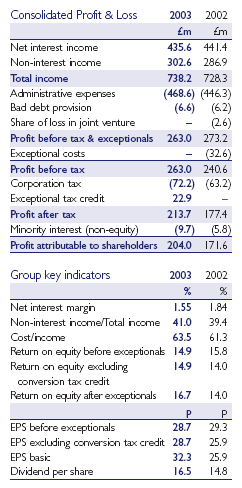 Group profit before tax and exceptional costs fell in 2003 to £263.0 million
from £273.2 million in a year with good performance in our Lending business
but difficult market conditions impacted some other parts of the Group.
No exceptional costs were incurred and profit before tax increased by 9%
to £263.0 million from £240.6 million. A small fall in interest income was
more than recovered by increasing non-interest income, resulting in a total
income increase of £9.9 million. Costs increased by 5% to £468.6 million
and the provision charge remained low.The Group's profit after tax increased
substantially, benefiting from a £22.9 million one-off tax credit. Basic
earnings per share increased to 32.3 pence and return on equity after exceptionals
rose from 14.0% to 16.7%.
Group profit before tax and exceptional costs fell in 2003 to £263.0 million
from £273.2 million in a year with good performance in our Lending business
but difficult market conditions impacted some other parts of the Group.
No exceptional costs were incurred and profit before tax increased by 9%
to £263.0 million from £240.6 million. A small fall in interest income was
more than recovered by increasing non-interest income, resulting in a total
income increase of £9.9 million. Costs increased by 5% to £468.6 million
and the provision charge remained low.The Group's profit after tax increased
substantially, benefiting from a £22.9 million one-off tax credit. Basic
earnings per share increased to 32.3 pence and return on equity after exceptionals
rose from 14.0% to 16.7%.
Net interest income fell by 1% in 2003. Strong growth in selective lending increased income and places the Group in a strong position for the future. However, we still saw significant decreases in income due to attrition in the former building society mortgage book which, in combination with the impact of lower interest rates on Savings and Treasury & Reserves interest income, reduced this positive impact and resulted in net interest income of £435.6 million.
Non-interest income grew by 5% to £302.6 million during 2003.The strong growth in mortgage broking income has been encouraging and, coupled with this, our Surveying business has developed well. Meanwhile, investment markets have remained depressed and income has been correspondingly disappointing. Estate Agency had a mixed year but recovered from a poor first half year in the later stages of 2003. Non-interest income also included a net gain from the sale and leaseback of a small number of properties.
Costs increased from £446.3 million to £468.6 million.This is due in part to the absorption of the new acquisitions made in the investment businesses Charcol Holden Meehan and Charcol Aitchison & Colegrave that will contribute to investment income in future years. Furthermore, increasing costs associated with dealing with regulatory requirements for both current and previous product sales are becoming more significant. Set against this, Bradford & Bingley has continued to drive down costs by improving efficiency in our operational support areas.
Our Lending business has grown strongly in 2003.This growth is based upon a cautious approach to the balance of risks and rewards associated with mortgage lending.We continue to be conservative and do not write unsecured personal loans, or offer credit cards, on our own balance sheet. All our loans are backed by the security of property, the vast majority of which are homes.The economic environment has remained benign with low interest rates, low unemployment and increasing house prices. This combination of factors and our continuing prudent approach means our provisions have increased by £5.0 million to £60.7 million and the profit and loss charge of £6.6 million is broadly similar to the previous year.
As part of our capital management programme the Group issued £150 million Tier I capital in May 2002 and the cost of this capital is included as minority interest (non-equity) in the Profit and Loss Account. This cost increased to £9.7 million in 2003 reflecting the full year amount compared to only seven months in 2002.
No exceptional costs were incurred during 2003. Furthermore, having reached agreement with the Inland Revenue, we have been able to release provisions against potential tax costs associated with the conversion from a building society in 2000.This £22.9 million release results in an unusually low tax charge of 18.7%.
Excluding the impact of the one-off tax credit, profits after tax increased to £190.8 million, enabling earnings per share to increase to 28.7 pence from 25.9 pence. After the benefit of the exceptional tax credit, earnings increased by 19% to £204.0 million and earnings per share by 25% to 32.3 pence.
Net interest income
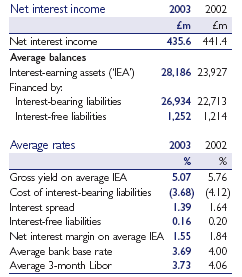 The considerable growth in our specialist Lending business generated an
increase in total balances and corresponding improvement in income in
that part of the business. However, the former building society mortgage
balances continue to decline and the loss of these balances has reduced
the positive impact of the new lending. Furthermore, the continued low
interest rates have restricted margins in the Savings business and reduced
earnings on the Group's reserves.
The considerable growth in our specialist Lending business generated an
increase in total balances and corresponding improvement in income in
that part of the business. However, the former building society mortgage
balances continue to decline and the loss of these balances has reduced
the positive impact of the new lending. Furthermore, the continued low
interest rates have restricted margins in the Savings business and reduced
earnings on the Group's reserves.
The success of the selective Lending business has generated an increase in interest earning assets of £4.3 billion, with this strong growth more than compensating for redemptions against the back book.The total yield on these assets declined as a result of the fall in general interest rates and the costs of the incentives associated with newer loans.
The costs of interest-bearing liabilities also fell as market rates dipped. A shift in the mix towards wholesale funding has increased the relative cost of financing for the Group, as would be expected when we continue to grow so successfully. A small decline in the margin on interest-free liabilities from 0.20% to 0.16% is the result of the lower base and inter-bank rate environment we experienced in 2003.
Non-interest income
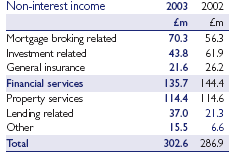 Non-interest income increased by 5% to over £300 million in 2003. Strong
performance in mortgage broking income and lending related fee income
were the main drivers of this growth. In a mixed year, although property
revenues were flat, the continued success of our Surveying business compensated
for the decline in Estate Agency revenue. It was difficult to attract
new investment business in the face of uncertain equity prospects and
general insurance income also reduced.
Non-interest income increased by 5% to over £300 million in 2003. Strong
performance in mortgage broking income and lending related fee income
were the main drivers of this growth. In a mixed year, although property
revenues were flat, the continued success of our Surveying business compensated
for the decline in Estate Agency revenue. It was difficult to attract
new investment business in the face of uncertain equity prospects and
general insurance income also reduced.
Mortgage broking revenues grew strongly by 25%.This business is now established as one of our most significant revenue streams and The MarketPlace and Charcol are the two largest mortgage broking names in the UK.
Investment related business continues to disappoint. A fall in income to £43.8 million reflects the continuing reluctance of customers to invest in equity based products despite a general improvement in 2003 after the poor performance of these markets in previous years. General Insurance income was also down.The main reason for this decline was the number of redemptions of mortgages from the former building society book that had linked buildings and contents insurance policies.
Lending related income increased strongly.This reflects a very positive year of new lending in our specialist businesses with arrangement fees from both new mortgage and commercial lending reaching record levels. This income includes the net income from our securitisation vehicles.
Other non-interest income benefited from the sale and leaseback of 13 high street properties at auction realising a net gain of £8.1 million.
Administrative expenses
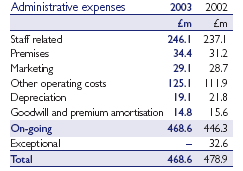 Total expenses increased during 2003 by 5%. The Group continues to focus
on ensuring that the operational support to the Lending and Distribution
businesses is managed efficiently. Group Operations functions have been
reviewed and reorganised during the last year. Significant improvements
in the unit costs in these areas have been achieved without the need to
charge any exceptional costs.
Total expenses increased during 2003 by 5%. The Group continues to focus
on ensuring that the operational support to the Lending and Distribution
businesses is managed efficiently. Group Operations functions have been
reviewed and reorganised during the last year. Significant improvements
in the unit costs in these areas have been achieved without the need to
charge any exceptional costs.
Staff costs increased by 4% to £246.1 million. Our staff are the mainstay of the business and the increase in costs reflects investment in a number of areas.We have absorbed the costs of AMS Ltd, our mortgage processing business, after our US partner exited the joint venture at the end of 2002.We have purchased two new businesses, Holden Meehan and Aitchison & Colegrave to strengthen our offering in the investment markets.
Premises costs increased to £34.4 million following increased rental costs resulting from transactions undertaken to transfer long-term ownership of a number of properties into the leasehold sector. Going forward this provides greater flexibility and reduces the risks and costs of under-utilised property.
Marketing costs remained stable and support to our Mortgage Express,The MarketPlace and Charcol brands has been rewarded by their success.These brands continue to win industry and consumer awards across all channels, reflecting the strength of our propositions.
Other operating expenses increased by 12%. Underlying improvements in information technology support have been achieved through our outsourced arrangements with IBM and BT. However, increasing costs in support of regulatory review and change have more than offset these improvements.
We are also investing in readiness for the impacts of the substantial number of new reporting and compliance rules that face our industry.These changes impact right across our business.There are new requirements for the processes applied to the sale of mortgages under the Financial Services Authority ('FSA') consultation papers CP 186, 197 and 198. Reporting to the FSA will change substantively as the Basel II framework is implemented. Whilst this will not be applied immediately, investment in new data analysis and credit scoring processes is ongoing.
The standards applicable to the reporting of company accounting and financial information are also undergoing a radical overhaul. From 2005, International Financial Reporting Standards will govern financial reporting for all publicly quoted companies. Bradford & Bingley has established a project to identify, analyse and prepare for the reporting changes that these new standards will require.This project team has developed detailed plans and is on track to ensure the required changes to accounting practices, systems and processes are implemented.
The general objectives of the increasing regulatory agenda are to promote ease of access and choice of financial products, and to promote better comparability and understanding of financial information amongst investors and other stakeholders.Whilst the Group fully supports these objectives, it is important to note that these activities are not without cost.
Bad debt provision
To provide for bad debts an additional £6.6 million (2002: £6.2 million)
has been charged to the Profit and Loss Account during 2003.This level
of charge demonstrates our conservative approach to lending and provisioning.We
make no unsecured loans to customers, ensuring bad debt costs remain low.
Total provisions on the Balance Sheet have increased.The amount we have set aside to provide against losses in our residential mortgages, securitised mortgages and commercial loan portfolios totals £60.7 million (0.23% of the total managed lending assets). The amount of specific provision against loans, where there is evidence that credit conditions on those individual loans has deteriorated, decreased to £5.5 million and is principally driven by continuing favourable economic conditions. General provisions against the statistical likelihood of losses across all our portfolios have declined, relative to loan balances.The low level of provisions is the result of our lending policies and the conditions in the markets in which we operate.These environmental conditions remain benign.
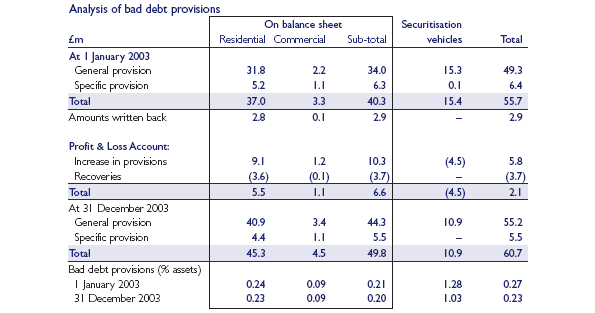
Taxation
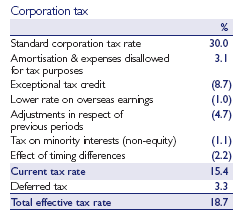 The 2003 tax charge equated to an effective rate of 18.7% (2002: 26.3%).The
underlying tax charge is a consequence of the nature and structure of
the earnings of the business and compliance with current and previous
tax law. The effective rate compared to the standard rate of corporation
tax is explained as follows:
The 2003 tax charge equated to an effective rate of 18.7% (2002: 26.3%).The
underlying tax charge is a consequence of the nature and structure of
the earnings of the business and compliance with current and previous
tax law. The effective rate compared to the standard rate of corporation
tax is explained as follows:
During 2003 the Group concluded discussions with the Inland Revenue on the tax treatment of the costs associated with the programme to convert Bradford & Bingley from a building society to a public limited company that took place in 2000. As a result, we are now able to release a provision of some £22.9 million.
Dividends
A final dividend of 11.0 pence per share has been proposed for payment
on 7 May 2004 which, together with the interim dividend of 5.5 pence per
share, gives a total dividend for the year of 16.5 pence per share (2002:
14.8 pence per share).This dividend reflects the Board's desire to ensure
that the dividends paid each year balance the combined objectives of providing
a growing return to shareholders with the need to invest the earnings
of the Group to finance future balance sheet growth.
Lending
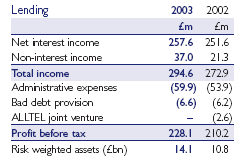 Lending profits increased strongly to £228.1 million, a 9% improvement.This
profit growth demonstrates the successful development of Mortgage Express
and our selective lending strategy.
Lending profits increased strongly to £228.1 million, a 9% improvement.This
profit growth demonstrates the successful development of Mortgage Express
and our selective lending strategy.
Gross new lending increased 70% to £9.9 billion and net new lending of £5.3 billion generated growth in balances of 26% to £25.9 billion. These figures include £1.4 billion of loans acquired from GMAC-RFC (£650 million in 2002) and Commercial and Housing Association lending of £2.2 billion.
Residential mortgage redemptions were £3.8 billion and the redemption rate of mortgages in the former building society book of 25% is similar to that in the general market.Total residential loan balances increased by 23% to £20.7 billion and total managed lending assets by 26% to £25.9 billion.
Net interest income increased during 2003 to £257.6 million as income from new specialist mortgages and commercial property loans outstripped the effect of the declining building society book.The net interest margin in Lending reduced to 1.17% as a result of the increasing proportion of newer loans on the Balance Sheet. Spreads on new specialist lending held up well, reflecting our strong origination and product development capability.
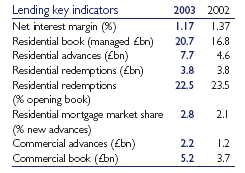 Fees
earned on the origination of new loans, both residential and commercial,
and administration services combined to give a strong growth in Lending
non-interest income of over 70%. Included within non-interest income is
the net return from our securitisation vehicles.
Fees
earned on the origination of new loans, both residential and commercial,
and administration services combined to give a strong growth in Lending
non-interest income of over 70%. Included within non-interest income is
the net return from our securitisation vehicles.
Management expenses in Lending increased to £59.9 million from £53.9 million in a year when new business activity continued a trend of rapid increase.The improvements in the operations and support processes in our Lending business are demonstrated by a significant improvement in the cost/assets under management ratio to 0.23% from 0.26%.The cost to income ratio was 20.3% (2002: 19.8%).The mix of new lending reflects our commitment to developing the business within niche sectors of the market that provide attractive rewards compared to their risks.The largest segment of our new loans was again in the buy-to-let market and accounted for 47% of new loans and now makes up 34% of total loan balances.The arrears and repossession experience in our buy-to-let book is significantly better than the residential mortgage market as a whole.Arrears of three months or more are just 0.25% of the book compared to the UK average for buy-to-let loans of 0.45% and a total mortgage market equivalent figure of 0.75%. Mortgage Express has been a key player in the development of the retail investment property market in the UK and this long experience enables us to maintain healthy margins whilst minimising bad debts.We have experienced just 30 repossession cases in the buy-to-let portfolio since its launch in 1996.
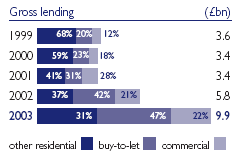 Another
market in which Bradford & Bingley has developed a strong position is
in mortgages to customers who self-certify their income. New lending in
this category made up 16% of advances in 2003 and accounts for 8% of the
total loan balances. Income is just one of many underwriting criteria
used to assess the credit status of a potential borrower.Typically, this
type of mortgage is suitable for self-employed borrowers, or people who
earn commission based income. Our loans in this segment are scrutinised
robustly, and all credit criteria are reviewed before loans are sanctioned.
Bad debts are low and just 0.99% of cases are three or more months in
arrears.
Another
market in which Bradford & Bingley has developed a strong position is
in mortgages to customers who self-certify their income. New lending in
this category made up 16% of advances in 2003 and accounts for 8% of the
total loan balances. Income is just one of many underwriting criteria
used to assess the credit status of a potential borrower.Typically, this
type of mortgage is suitable for self-employed borrowers, or people who
earn commission based income. Our loans in this segment are scrutinised
robustly, and all credit criteria are reviewed before loans are sanctioned.
Bad debts are low and just 0.99% of cases are three or more months in
arrears.
Our Commercial Property lending business performed strongly in 2003. New loans were £1.9 billion and balances increased to £3.4 billion. Our Commercial Property team has been active in building relationships with a number of larger banks, consequently becoming an increasing participant in a number of loan syndications. Housing Association lending also increased.This low-risk segment of the market is extremely competitive and opportunities to lend at attractive margins are correspondingly difficult. Together, Commercial Property and Housing Association accounted for 22% of new lending and now comprise 20% of total loan balances.

Residential arrears
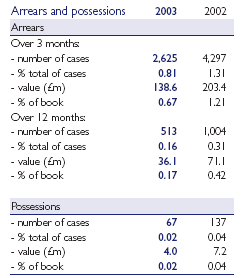 As a result of our careful approach to underwriting, and reflecting stable
economic conditions with low interest rates, low, unemployment and high
house price growth, overall arrears and bad debts have been low. The number
of cases in possession was 67, a reduction from the previous year, notwithstanding
the significant increase in balances.
As a result of our careful approach to underwriting, and reflecting stable
economic conditions with low interest rates, low, unemployment and high
house price growth, overall arrears and bad debts have been low. The number
of cases in possession was 67, a reduction from the previous year, notwithstanding
the significant increase in balances.
The value of arrears and possessions is also low at £178.7 million, only 0.86% of the book, an improvement over the figure of 1.67% at the end of 2002.
The strong credit performance has enabled a reduction in provisions relative to total balances and a Profit and Loss Account charge similar to that in 2002.
Savings
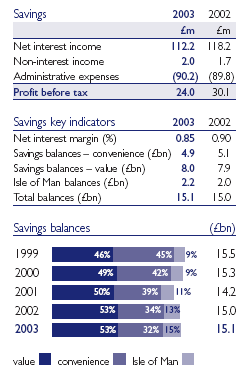 Savings income declined in 2003 by £5.7 million to £114.2 million.The
prevailing low interest rate environment and an ongoing migration to higher
rate, lower margin investment products reduced margins on these balances.This
shift in balances from convenience to longer-term value products such
as fixed rate and term accounts has led to a decline in margins to 0.85%
from 0.90%. Savings balances remained stable at £12.9 billion and, combined
with £2.2 billion balances in our Isle of Man based offshore deposit business,
contribute 47% (2002: 59%) of total Group funding.
Savings income declined in 2003 by £5.7 million to £114.2 million.The
prevailing low interest rate environment and an ongoing migration to higher
rate, lower margin investment products reduced margins on these balances.This
shift in balances from convenience to longer-term value products such
as fixed rate and term accounts has led to a decline in margins to 0.85%
from 0.90%. Savings balances remained stable at £12.9 billion and, combined
with £2.2 billion balances in our Isle of Man based offshore deposit business,
contribute 47% (2002: 59%) of total Group funding.
Treasury and Reserves
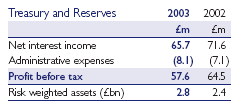 Treasury
and Reserves income fell in 2003, particularly in the second half of the
year as the effects of a lower interest environment flowed through to
earnings. Interest earnings relate principally to the investment of the
Group's reserves, and the yield on those investments fell.
Treasury
and Reserves income fell in 2003, particularly in the second half of the
year as the effects of a lower interest environment flowed through to
earnings. Interest earnings relate principally to the investment of the
Group's reserves, and the yield on those investments fell.
Group Treasury has a number of responsibilities including management of the Group's reserves and liquidity, operation of policies to manage both interest rate and currency risk, and raising funds and capital to finance the other parts of the business. It is this last responsibility that has been exercising the Treasury team during 2003 in support of the successful growth of the Lending business.We have sourced new funding in Europe, the Far East and the US bringing new capital market investors to Bradford & Bingley. Non-retail deposits increased by £6.2 billion to £14.1 billion and make up 44% (2002: 31%) of total balance sheet financing.
Distribution
 Distribution profits fell to £10.4 million in 2003 in a mixed year for
this part of our business.
Distribution profits fell to £10.4 million in 2003 in a mixed year for
this part of our business.
Income from mortgage broking continued its strong growth, increasing by 25% to £70.3 million, consolidating the strength of this now well established segment of our business. Bradford & Bingley is the largest mortgage broker in the UK and operates under two well known brands.The strength of these brands,The MarketPlace and Charcol, reflects the recognition by the customer of the value of trusted advice and choice. Bradford & Bingley remains the largest national high street presence offering this proposition to consumers.
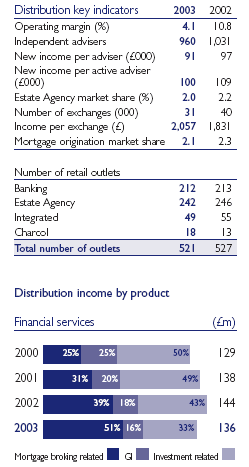
Revenue from the sale of investment products fell to £43.8 million and this part of the business is the most affected by the changes to the regulation of the financial services market. However, we are clear that there remains an ongoing need for consumers to invest for the future and close the well acknowledged savings gap. During 2003 we purchased two businesses specialising in providing investment and retirement planning advice, Charcol Holden Meehan and Charcol Aitchison & Colegrave.
Overall, we have reduced the number of advisers providing investment services and switched some to focus on the provision of mortgage broking, reflecting the evolving nature of these markets.
General Insurance sales also fell, down £4.6 million to £21.6 million.This income stream has been particularly affected by the reduction in the size of the former building society mortgage portfolio as these mortgages were often sold with linked insurance.This practice is no longer common and we are pleased that during the latter half of 2003 our general insurance proposition has been re-launched. Early signs for this improved service are encouraging.
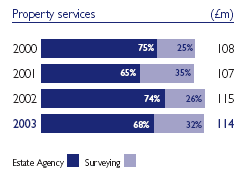
The income from property services remains constant at £114.4 million. Underlying this is a reduction in Estate Agency revenues in a year that was definitively one of two halves, and a rise in income from our substantial Surveying business. Estate Agency suffered the effects of a stagnant period in the Spring. During this period, house sales both across the market and for Bradford & Bingley Estate Agents fell sharply. However, we are pleased to report that during the second half we improved both sales and margins in this business to deliver much improved performance. Overall, income from Estate Agency fell reflecting lower sales, although this fall was somewhat mitigated by higher income per exchange resulting from improved margins and increased house prices.
The Surveying business has continued to strengthen with the development of the SecureMove branded service and the acquisition of Douglas Duff, a small surveying business based in the south east of England. Income from Surveying increased by 24% to £37.1 million.
Distribution costs increased year-on-year, in part due to the acquisitions noted previously. In addition, substantial investment was made in ensuring that our selling practices and procedures were fully compliant with the requirements of the regulator.Total costs were £239.8 million and we continued to invest in our distribution brands. Further work to improve the management and support to the sales teams has been ongoing in 2003 and this positions us favourably for the coming year.
Group Services
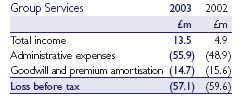 Income in Group Services increased by £8.6 million to £13.5 million.This
increase arose from profits on the sale of a small number of properties
as we took advantage of strong investor demand for commercial property
in sale and leaseback transactions, releasing a gain of £8.1million.
Income in Group Services increased by £8.6 million to £13.5 million.This
increase arose from profits on the sale of a small number of properties
as we took advantage of strong investor demand for commercial property
in sale and leaseback transactions, releasing a gain of £8.1million.
Group Services costs increased to £55.9 million from £48.9 million.The main driver of this cost increase is additional activity associated with dealing with customer claims for sales of regulated products in previous years.
Balance Sheet
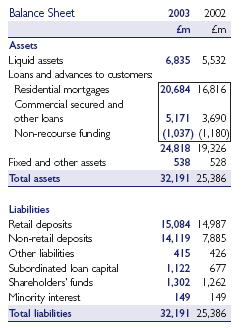 The Group's total assets have increased by 27% to £32.2 billion during
2003.This increase is driven by the success of our lending strategy which
has generated substantial growth in both specialist residential and commercial
assets. Liquidity increased and it is managed to provide a stable source
of cash flow to the Balance Sheet at an acceptable level of return.
The Group's total assets have increased by 27% to £32.2 billion during
2003.This increase is driven by the success of our lending strategy which
has generated substantial growth in both specialist residential and commercial
assets. Liquidity increased and it is managed to provide a stable source
of cash flow to the Balance Sheet at an acceptable level of return.
The Balance Sheet growth has been funded through wider access to wholesale markets that have remained both deeper and more cost effective than the equivalent retail deposit markets.The main source of these funds has been our Euro medium term programme, but funds have also been raised in other markets around the world.
Capital structure
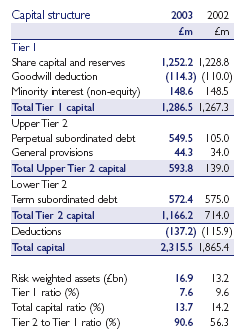 During 2003 Bradford & Bingley completed a share repurchase programme,
which commenced in 2002 with the aim of buying £150.0 million worth of
the Group's equity. This repurchase programme was undertaken to re-balance
the Group's capital away from equity in order to improve efficiency. In
total, 47.9 million shares were purchased and have been cancelled.
During 2003 Bradford & Bingley completed a share repurchase programme,
which commenced in 2002 with the aim of buying £150.0 million worth of
the Group's equity. This repurchase programme was undertaken to re-balance
the Group's capital away from equity in order to improve efficiency. In
total, 47.9 million shares were purchased and have been cancelled.
In addition to reducing the amount of equity capital, the Group has increased total capital, raising £450 million in two separate subordinated debt issues; £250 million in April, and £200 million in December. Both issues were well received by the market and were fully subscribed.
As a result of these actions, and the addition of the current year's retained profits, total capital increased to £2.3 billion. Our flourishing lending business generated an addition to risk weighted assets of £14.1 billion, bringing the total to £16.9 billion. Consequently, the total capital ratio of the Group as at December 2003 was 13.7% and the Tier I ratio was 7.6%, well within our target ratios.
This ongoing programme ensures the Group's capital is efficiently managed and provides a stable platform to finance the growth of the business. As part of this activity we have an active schedule of work aimed at preparing us for the changes anticipated from the responses of the European Union and the FSA to the proposed Basel II capital adequacy framework.
Risk management
and control
In the ordinary course of business, the Group is exposed to, and manages
a variety of risks, with operational, credit, market and liquidity risk
being of particular significance.The management of risk is fundamental
to the Group, with the Board having responsibility for the overall system
of internal control and for reviewing its effectiveness.
The Board has delegated specific risk monitoring and control responsibilities to the Audit, Risk & Compliance Committee, the Group Risk Committee and the Asset & Liability Management Committee ('ALCO').
Each business area within the Group is responsible for the identification and assessment of their particular risk exposures, and implementing risk management policies, limits and procedures as approved by the Board.
The key areas of risk the Group faces are discussed below.
Operational Risk
Operational risk is defined as the potential risk of financial loss or
impairment to reputation resulting from inadequate or failed internal
processes and systems, from the actions of people or from external events.The
Group's business units manage this risk through appropriate controls and
loss mitigation actions, including insurance.These actions include a balance
of policies, appropriate procedures and internal controls to ensure compliance
with laws and regulations. In addition, specialist support functions provide
expertise in operational risk areas such as information security, financial
services compliance, fraud management, security and business continuity
management.
Credit Risk
Credit risk is defined as the potential of financial loss if counterparties
(borrowers) are not able to meet their obligations as they fall due.The
Group is firmly committed to the management of this risk in both its lending
and wholesale money market activities. In its core lending activities,
the Group employs sophisticated credit scoring, underwriting and fraud
detection techniques that support sound credit decision making and work
to minimise losses. A proactive approach to the identification and control
of bad and doubtful debts is maintained in the Credit Risk Management
and Credit Control areas.
Lending policies and limits are reviewed and approved annually by the Board, with the attendant credit risk processes defined and managed centrally.The Group Risk Committee ensures that any exposure to credit risk, significant changes in policy, or expansion into new areas of business remain within overall risk exposure levels as agreed by the Board.
Authorised credit risk limits for wholesale money market counterparties reflect the size, depth and quality of a counterparty's capital base and, where published, credit ratings assigned by the major credit rating agencies. The policies and limits covering treasury counterparty credit risk exposure are reviewed and approved annually by the Board.
Market Risk
Market risk is defined as the potential adverse change in Group income
or Group net worth arising from movements in interest rates, exchange
rates or other market prices. Market risk exists to some extent in all
of the Group's businesses. Effective identification and management of
market risk is essential for maintaining stable net interest income.
Interest rate risk is the most significant form of market risk to which the Group is exposed. It arises from mismatches between the re-pricing dates of the interest-bearing assets and liabilities on the Group's Balance Sheet, and from the investment profile of the Group's free reserves.Treasury is responsible for managing this exposure within the market risk exposure limits set out in the Group's policies. The Group's exposure to market risk is governed by the Balance Sheet Management policy as approved the Board.This policy sets out the nature of the market risks that may be taken along with aggregate risk limits, and stipulates the procedures, instruments and controls to be used in managing market risk.
The Board has delegated responsibility for managing the Group's exposure to market risk to the ALCO. It is the ALCO's responsibility to approve strategies for managing market risk exposures and ensuring that Treasury implements the strategies so that the exposures are managed within the Group's approved policy limits.The ALCO meets at least monthly and reviews reports and other analyses showing the Group's exposure to market risk.
Foreign Exchange Risk
The Group raises and invests funds in currencies other than sterling.
Accordingly, foreign exchange risk arises from activities related to the
Group managing borrowing costs and investment returns. As with interest
rate risk,Treasury is responsible for managing this exposure within the
limits as set out in the Group's policies.
Foreign exchange risk is managed primarily through the use of currency swaps and forward foreign exchange contracts. It can be also managed, when appropriate, by foreign currency denominated liabilities being matched with assets denominated in the same foreign currency.
Liquidity Risk
It is Group policy to ensure that funds are available at all times to
meet the Group's obligations, including the withdrawal of customer deposits,
the draw-down of customer facilities and growth in the Balance Sheet.The
development and implementation of liquidity policy is the responsibility
of the ALCO.
The day-to-day management of liquidity is the responsibility of Treasury, which provides funding to, and takes surplus funds from, each of the Group's businesses as required. Liquidity policy is approved by the Board and agreed within a framework established by the Financial Services Authority. Regulatory guidelines and potential outflows of funds drive the scope and nature of the Group's holdings of readily realisable liquid assets.
Derivatives
The Board, through the Balance Sheet Management policy, has authorised
the use of certain derivative instruments for the purposes of supporting
the strategies and operational business activities of the Group, and for
managing the risk of loss arising from adverse changes in interest rates
and foreign exchange rates.
Detailed disclosures on interest rate risk, foreign exchange risk, and the use of derivatives are set out in Note 31 to the Financial Statements in accordance with Financial Reporting Standard No. 13, Derivatives and other Financial Instruments.
Rosemary Thorne
Group Finance Director
